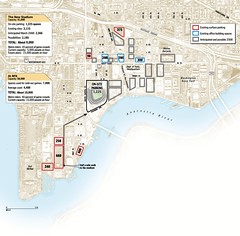Quote of the day (transportation demand management, baseball)
You wouldn't know it from the content of this blog, but I'd prefer to write about more things than just transportation and the Washington Nationals. Yesterday's Post had so much grist for the mill on both that I was chomping at the bit to write about it, but I had too much other stuff to do.
Newspapers reported on a press conference held by the DC Government, about the number of parking spaces that are available in the area around the forthcoming baseball stadium. See "D.C. Says It Has Found Parking Near Stadium" subtitled "Almost 9,000 Spots Are Possible, Officials Say" in the Washington Post.
 From Parking Proposal, Washington Post. SOURCES: D.C. Department of Transportation, Satellite Image by GeoEye GRAPHIC: Laris Karklis, April Umminger and Nathaniel Vaughn Kelso, The Washington Post - July 14, 2006.
From Parking Proposal, Washington Post. SOURCES: D.C. Department of Transportation, Satellite Image by GeoEye GRAPHIC: Laris Karklis, April Umminger and Nathaniel Vaughn Kelso, The Washington Post - July 14, 2006.This is a perfect example of what I wrote about on Thursday, the need to create "Transportation Management Districts" as a way to plan and coordinate various transportation issues in particular areas. (See "Delivery services in the city and the creation of transportation management districts.")
It's also an example of the absolute necessity of requiring Transportation Demand Management, especially car trip reduction requirements, as part of all development projects, as well as for extant commercial and institutional facilities. And while I write about this frequently, I wrote about that earlier in the week also. (See "Transit without borders or five omissions "in" the Transportation Element of the DC "Comprehensive" Plan .")
If TDM were required, instead of the Lerners and Stan Kasten thinking about how they can create a sea of parking lots, they'd have to look at the problem from a completely different perspective, how to:
-- maximize mobility;
-- maximize the use of extant assets;
-- expand transportation infrastructure efficiently and cost-effectively;
-- minimize the wasteful use of land, the most precious asset possessed by the District of Columbia.
 Large asphalt or cement parking lots are a common feature of urban landscapes. These impervious surfaces generate large amounts of stormwater runoff and also store solar radiation, which contributes to elevated nighttime temperatures. These parking lots are mostly empty for long periods of time. From "Structural Soils for Urban Applications."
Large asphalt or cement parking lots are a common feature of urban landscapes. These impervious surfaces generate large amounts of stormwater runoff and also store solar radiation, which contributes to elevated nighttime temperatures. These parking lots are mostly empty for long periods of time. From "Structural Soils for Urban Applications."Instead, you get the quote of the day:
"It's not simply enough to build a stadium, plop it down and hope that it works," Kasten said in a recent interview. "Part of that is having the ability to get there easily and to park conveniently. That's part of what will draw people there. If they think they can't get there, they will stay away."
He has it right that it's not simply enough to build a stadium.
It's also way more important to do more than build a sea of parking.
WRT the latter point, I wrote something in March 2005 about this, using the example of the LoDo District in Denver. See "Denver's Delightful LoDo District-- A Lesson for Stadium District Development."
While everybody writes about the impact of Coors Field on LoDo, the fact is that the area, the old warehouse district of the city, was long on the path to revitalization before baseball ever came on the scene. Furthermore, the blog entry above is based on an AP travel story about visiting the LoDo district--in December!--when baseball isn't played. In many respects, baseball is but an afterthought to the successful revitalization of LoDo, a multi-decade process also described in a book frequently mentioned in this blog Cities: Back from the Edge.
Friday's Post also contained a review of a new film based on a story by Phillip K. Dick. The review "'A Scanner Darkly': Finely Controlled Substance," has an interesting paragraph describing the movie's setting:
"seven years from now" in Anaheim, pulls us into a world so lost in narcotic oblivion (20 percent of the population is hooked on a drug called Substance D) that no one grasps the larger dystopia.
It struck me while reading that today's equivalent of "Substance D" is the single use, automobile-dependent planning and development paradigm that imprints most every aspect of how the average American "thinks" (approaches) land use, transportation, and planning issues.
Speaking of auto-dependence, apparently the metric used by traffic engineers is that the average suburban household conducts 10 separate car trips per day. See the Post article "VDOT Says Project Would Jam Roads." From the article:
The Virginia Department of Transportation has warned local officials that a proposal to allow as many as 28,000 new houses near Dulles International Airport in Loudoun County would create gridlock not only in southeastern Loudoun but in neighboring Fairfax and Prince William counties as well...The proposal also would generate up to 300,000 car trips a day and by 2025 would cause stop-and-go driving conditions on a dozen regional roads...
Such is the foundation of the thinking that fuels the desires of the Washington Nationals to have as much surface parking as possible.
Substance D.
Perhaps the D = driving dystopia?
Index Keywords: stadiums-arenas; transportation



0 Comments:
Post a Comment
<< Home